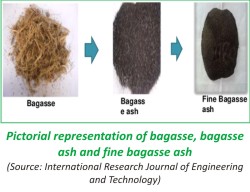Utilisation of Waste Bagasse
Ash in Concretes:
An Eco-Efficient Approach
India
ranks as the second largest producer of sugarcane globally after Brazil and
it produces approximately 350 million tonnes of sugarcane annually. The
state of Uttar Pradesh is the largest producer in India which covers nearly
50% of the total sugarcane production followed by Maharashtra, Karnataka,
Tamil Nadu, Andhra Pradesh, Gujarat, Bihar, Haryana and Punjab1.
From sugarcane about 40-50% fibrous residue is obtained after extraction of
sugar juice which is known as sugarcane bagasse. This bagasse is used as
fuel in boilers to produce steam which runs the turbines generating power
for plant operation. It leaves behind approximately 8-10% ash as solid waste
which is known as sugarcane bagasse ash (SCBA). Approximately 15 million
tonnes of SCBA is generated yearly in India which is deposited in open
spaces or nearby agricultural fields causing significant land and water
pollution2. These issues essentially demand the effective
management of solid waste generated from agro based sugarcane industries
through an eco-efficient approach.
Several studies were carried out with sugarcane
bagasse ash which reveal the presence of significant amount of silica after
its controlled burning. The high silica content makes this sugarcane bagasse
ash as a supplementary cementitious material for cement and concrete
applications3. The quantity and reactivity of silica in bagasse
ash varies with its sources. There are so many parameters like the method of
cogeneration, variety of sugar plants, collection points etc. which control
the quality of bagasse ash. Inclusion of sugarcane bagasse ash in standard
clauses requires evident experimental results on its quality obtained from
different sources. Identification of the influential parameters and
specifying their reactivity limits are crucial in obtaining bagasse ash to
meet the quality criteria. Hence, there is a need to modify properties of
bagasse ash obtained from any source to be a suitable material as a partial
replacement of cement in concrete.
Construction industries are looking for suitable additives for partial replacement of cement to reduce the cost of making concrete with improved quality (fresh, hardened and durability properties). Fly ash and slag are extensively used in this regard in states like Maharashtra but the availability of the fly ash and slag, especially in the southern part of the state is negligible. Transporting fly ash/slag beyond certain distances is not economically feasible. But southern Maharashtra has many sugar cane units. The sugar cane bagasse ash from these units can be used as partial replacement for cement in concrete.
It is expected to have variability in the composition and quality of sugarcane bagasse ash (SCBA). However, most of the research studies use SCBA from single source and investigate corresponding properties. This will not improve the acceptance or utilisation of SCBA on a larger scale. To improve the utilisation, it is necessary to have an understanding about the variability of the sources and developing a suitable treatment process to make SCBA as a suitable material for partial replacement in cement.
Following are the key steps which are required to successfully use bagasse ash as an effective cementitious material for cement and concrete applications:
-
A simple methodology for identification of the quality of bagasse ash and development of appropriate pre-treatment process (thermal or mechanical or a combination) for bagasse ash of any quality is required to be established. This will enable the MSMEs to decide the suitable treatment process depending on the quality of bagasse ash received from different sugar cane industries.
-
Performance index for treated bagasse ash is required. This index will help classify the bagasse ash after the treatment process to decide the replacement level for OPC in concrete and building products.
-
Industrial scale production of bagasse ash with suitable treatment process will give confidence to the industry to set up bagasse ash treatment plants.
-
Economic attributes for production of treated bagasse ash at industrial scale will encourage the companies to invest in installing bagasse ash treatment plants.
-
A proper resource mapping of the sugarcane bagasse ash in India. This will enable the investors/ MSMEs to decide on the location of bagasse ash treatment plants. ■
References:
1 3rd Advance estimates for sugar season 2017-18. March 2018;
Vol. 49, No.7
2 Indian Journal of Geo Marine Science, vol.47 , October 2018,
1934-1945
3 Indian Concrete Journal , July 2015
Palas Kumar Haldar
pkhaldar@devalt.org